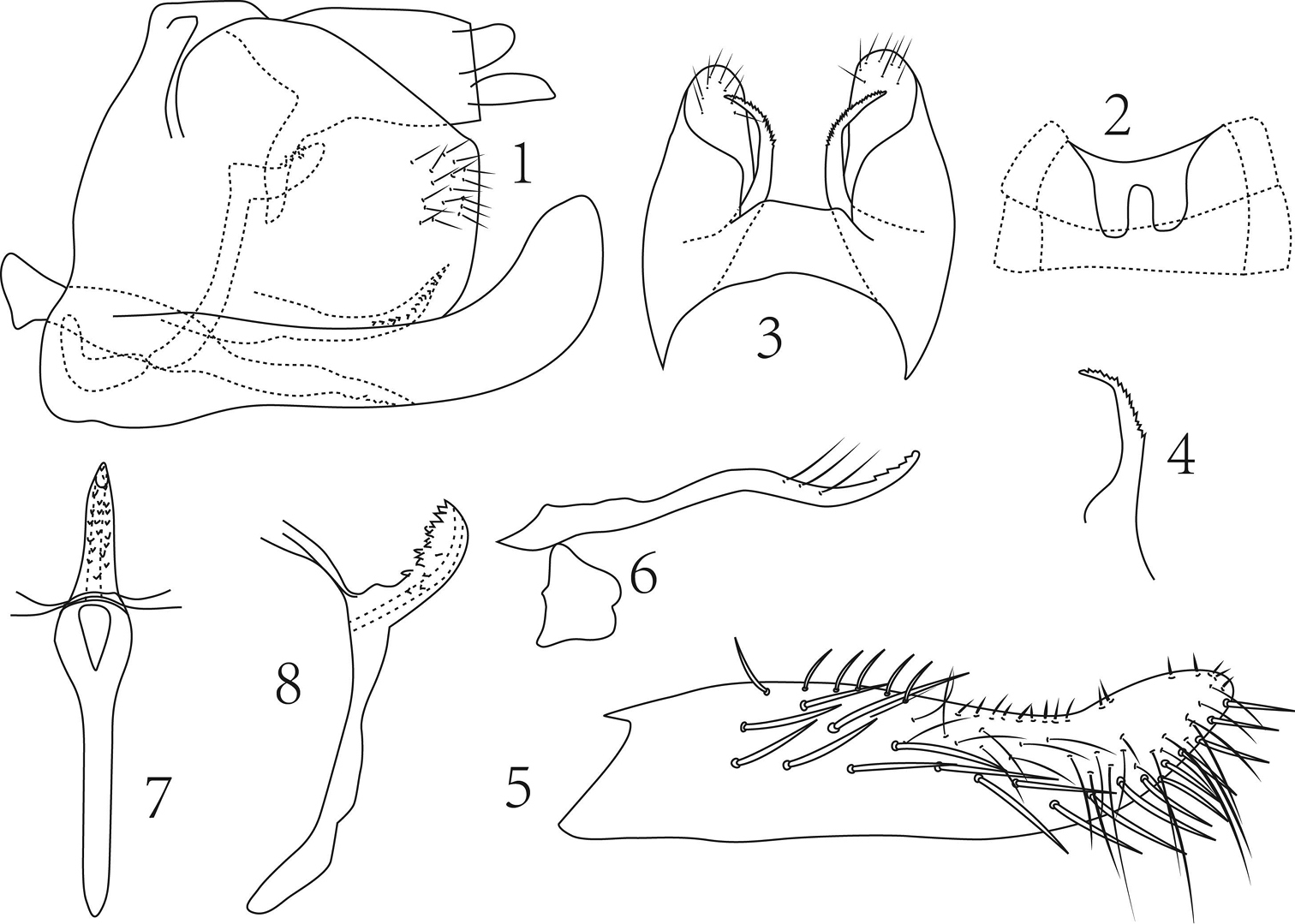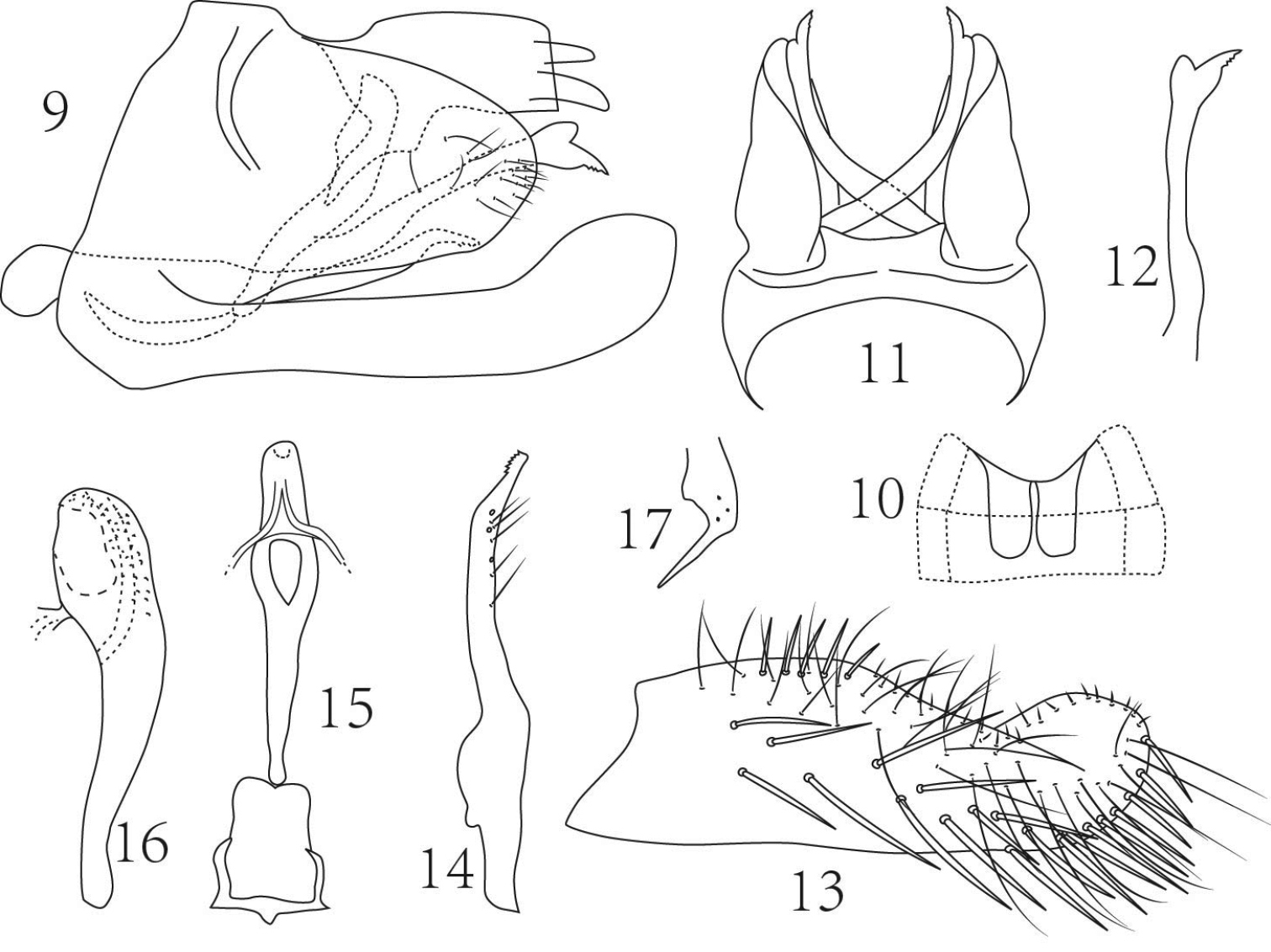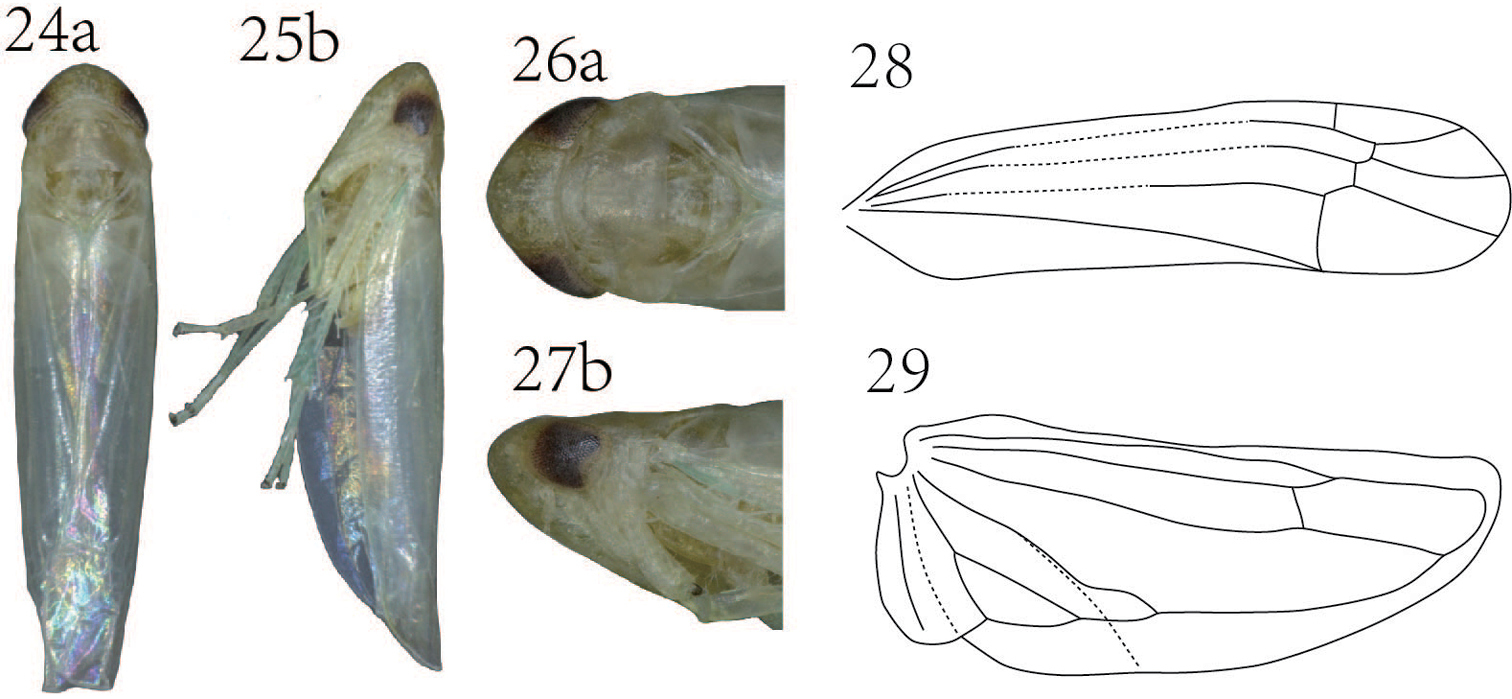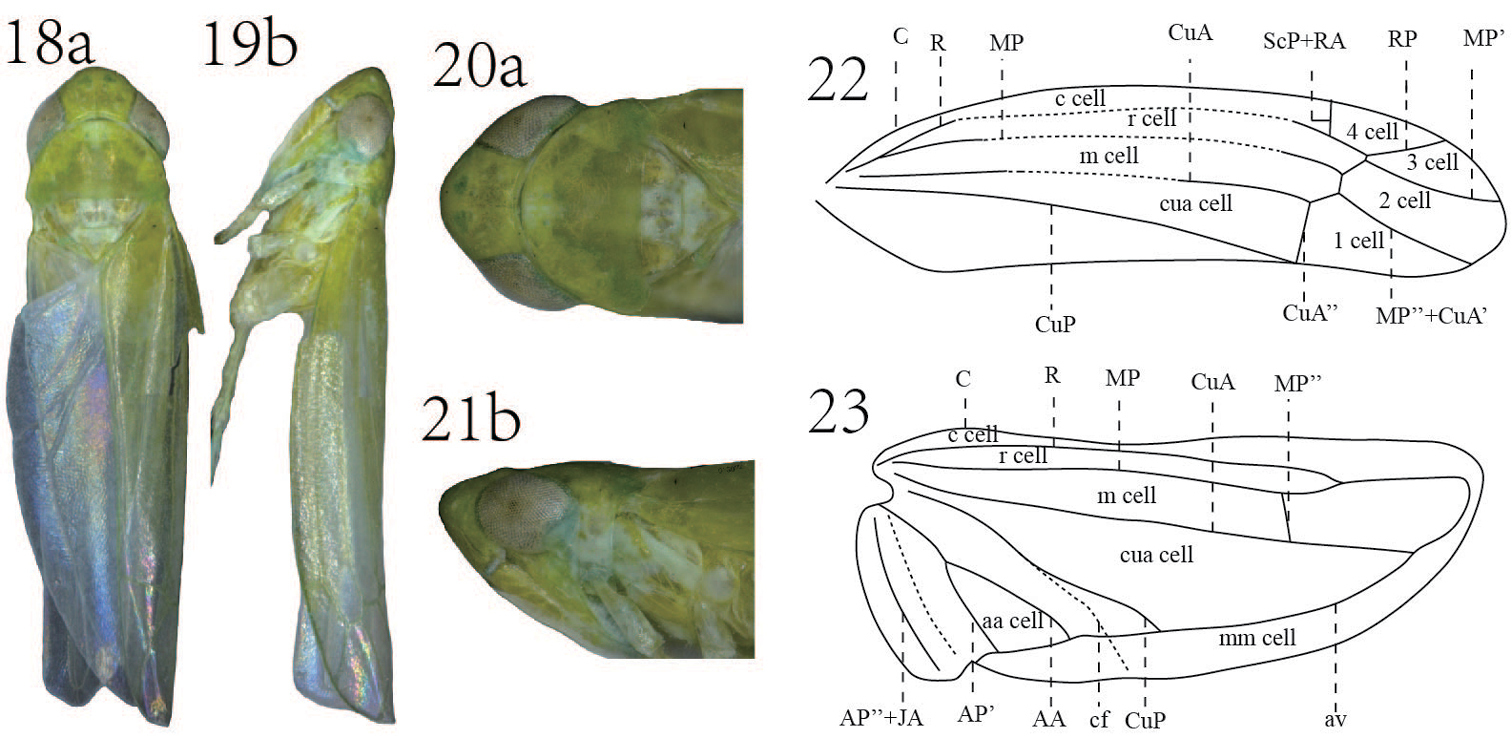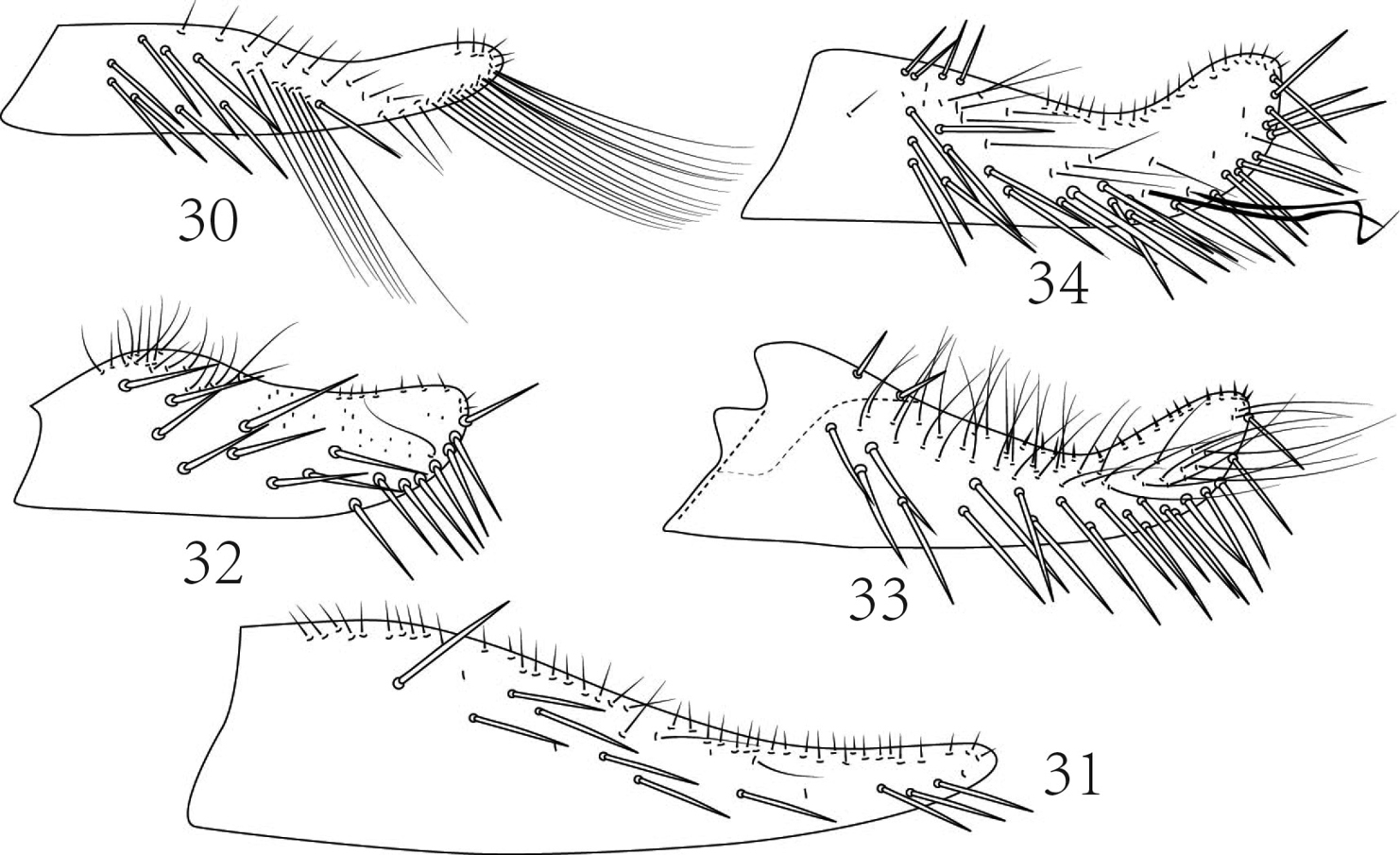






Citation: Yu XF, Yang MF (2014) Two new species of the leafhopper subgenus Empoasca (Empoasca) Walsh (Hemiptera, Cicadellidae, Typhlocybinae, Empoascini) from China. ZooKeys 437: 25–32. doi: 10.3897/zookeys.437.7563
Two new species of the leafhopper subgenus Empoasca (Empoasca) namely, E. (E.) dorsodenticulata Yu & Yang, sp. n. and E. (E.) spiculata Yu & Yang, sp. n. from China are described and illustrated and a key provided for Chinese subgenera of Empoasca.
Subgenera, Key
The leafhopper genus Empoasca Walsh, 1862 includes 11 subgenera (
The methods and terminology follow
Empoasca viridescens Walsh (a junior synonym of Tettigonia fabae Harris, 1841).
Body color green to yellowish, with variable symmetrical patches on head and thorax; coronal suture not reaching midlength of crown (Figs 18a, 20a, 24a, 26a); forewing with RP and MP’ stalked (Fig. 22) or separated (Fig. 28), hindwing with CuA unbranched (Fig. 23, 29); male pygofer, with fine sparse setae distally, macrosetae absent, ventral pygofer appendage present (in some species processes crossed in dorsal view), free from pygofer lobe, at least for halflength of pygofer (Figs 1, 9); subgenital fig broad basally, basal series of setae on outer margin and an oblique series of macrosetae from base to apex bi-seriate basally (Figs 5, 13); paramere elongate, curved, with apical teeth (Figs 6, 14); aedeagus with preatrium present, shaft without processes or occasionally with pair of processes, gonopore apical on ventral surface, dorsal apodeme poorly developed or absent (Figs 7, 8, 15, 16); anal tube processes distinct.
Empoasca (Empoasca) dorsodenticulata Yu & Yang, sp. n. 1 male genital capsule, lateral view 2 male abdominal apodemes 3 male pygofer, dorsal view 4 ventral pygofer appendage, dorsal view 5 subgenital fig, ventral view 6 paramere and connective 7 aedeagus, dorsal view 8 aedeagus, lateral view.
Empoasca (Empoasca) spiculata Yu & Yang, sp. n. 9 male genital capsule, lateral view 10 male abdominal apodemes 11 male pygofer, dorsal view 12 ventral pygofer appendage, dorsal view 13 subgenital fig, ventral view 14 paramere 15 aedeagus and connective, dorsal view 16 aedeagus, lateral view 17 anal tube process.
Empoasca (Empoasca) spiculata Yu & Yang, sp. n., 24–25 whole body 26–27 head and thorax 28 forewing 29 hindwing a dorsal view b lateral view.
Empoasca (Empoasca) dorsodenticulata Yu & Yang, sp. n. 18–19 whole body 20–21 head and thorax 22 forewing 23 hindwing a dorsal view b lateral view.
Worldwide.
http://zoobank.org/D485282D-C23B-4CC4-B628-22179ACC251A
Holotype: male, Kuankuoshui, Guizhou Province, 14 August 2010, coll. Xiaofei Yu. Paratypes: 1 male, Shiwandashan, Guangxi Province, 4 May 2011, coll. Rong Huang; 1 male, Liupanshui, Guizhou Province, 2 June 2012, coll. Maofa Yang, Zhijiang Bai and Xiaofei Yu.
Length. Male: 4.0–4.1mm.
Green to yellowish (Fig. 18a). Crown with a green patch each side of coronal suture (Figs 18a, 20a). Face in some species with an off-white longitudinal stripe on anteclypeus (Figs 19b, 21b). Scutellum with a whitish stripe medially (Figs 18a, 20a). Forewing with RP and MP’ stalked at base (Fig. 22).
Male ventral abdominal apodemes reaching segment 4 (Fig. 2). Male pygofer lobe with dorsal margin oblique and apical margin straight in lateral view, with fine setae adjacent apical margin; ventral pygofer appendage shorter than pygofer, tapering caudad, subapically denticulate; dorsal bridge about 1/3 length of pygofer (Figs 1, 3, 4). Subgenital figs elongate, with 20 macrosetae arranged obliquely in two basal rows centrally and a single distal row on lateral margin, ca. 25 elongate fine setae and medial margin with 6 basal group macrosetae followed by ca. 16 spine-like setae (Figs 1, 5). Paramere as in Fig. 6. Aedeagus with elongate preatrium; shaft slightly expanded near apex in lateral view, tapered from base to apex in ventral view, apical 1/3 with numerous irregular denticles dorsally (Figs 1, 7, 8). Anal tube process slightly sinuate (Fig. 1). Connective lamellate (Fig. 6).
The new species name alludes to the dorsal denticles on the aedeagal shaft.
The new species is similar to Empoasca (Empoasca) borowikae Dworakowska, 1976 but differs in having the male ventral abdominal apodemes reaching segment 4, ventral pygofer appendage denticulate near apex and apical 1/3 of aedeagus with dorsal denticles. The new species is also similar to Empoasca (Empoasca) gutianensis Liu, 2011 but differs in the aedeagus without denticles ventrally and anal tube process sinuate.
http://zoobank.org/4CDD261B-E282-4D5F-9F8F-26BA4CA306B2
Holotype. male, Luya mountain, Shanxi Province, 19 August 2011, coll. Hu Li; Paratypes: 5 males, Lvliang mountain, Shanxi Province, 22 August 2011, coll. Hu Li, Zhihua Fan and Xiaofei Yu (1 male, BMNH).
Length. Male 3.9–4.1 mm.
Yellowish (Fig. 24a). A yellow stripe along coronal suture (Figs 24a, 26a). Scutellum with a central whitish streak (Figs 24a, 26a). Forewing with RP and MP’ stalked at base or separated (Fig. 28).
Male ventral abdominal apodemes reaching segment 4 (Fig. 10). Male pygofer lobe tapered to rounded apex with ca. 15 setae, ventral pygofer appendage extended far beyond pygofer, procceses crossed in dorsal view, apex expanded and forked, lower branch serrate; dorsal bridge about 1/4 length of pygofer (Figs 9, 11, 12). Subgenital figs relatively broad with 20 macrosetae arranged obliquely in two basal rows centrally and a single distal row on lateral margin, and ca. 37 elongate fine setae from base to apex and medial margin with 5 basal group macrosetae followed by ca. 22 spine-like setae (Figs 9, 13). Paramere as Fig. 14. Aedeagus club-shaped in lateral view; shaft dorsally laterally compressed and less sclerotized, ventrally spiculate, with apex broadly rounded in ventral view; (Figs 9, 15, 16). Anal tube process falcate, apex spine-like (Figs 9, 17). Connective lamellate (Fig. 15).
The new species name alludes to the ventral spicules on the aedeagal shaft.
The new species differs from other members of the subgenus in having the ventral pygofer appendage forked, aedeagal shaft laterally compressed dorsally and ventrally spiculate.
| 1 | Subgenital figs with very long fine setae distally (Fig. 30) | Empoasca (Distantasca) |
| – | Subgenital figs with macrosetae distally (Figs 31, 32, 33, 34) | 2 |
| 2 | Pygofer lobe with rigid microsetae at ventral margin and ventral pygofer appendage short; subgenital figs elongate and tapered to narrow apex, with all outer marginal setae short (Fig. 31) | Empoasca (Okubasca) |
| – | Pygofer lobe without rigid microsetae at ventral margin and ventral pygofer appendage long (Fig. 1); subgenital figs moderately long and tapered to broadly rounded apex, with outer basal group of long macrosetae and more distal short setae (Figs 32, 33, 34) | 3 |
| 3 | Subgenital figs very short and broad (Fig. 32) | Empoasca (Livasca) |
| – | Subgenital figs elongate | 4 |
| 4 | Subgenital figs distinctly broader basally than distally (Fig. 33) | Empoasca (Matsumurasca) |
| – | Subgenital figs slightly broader basally than distally (Fig. 34) | Empoasca (Empoasca) |
Empoasca subgenera from China, subgenital figs (type species except 33). 30 Empoasca (Distantasca) terminalis (following
We sincerely thank Mr M. D. Webb (Department of Entomology of The Natural History Museum, England) for reviewing the MS and giving his kind help. We are also grateful to Miss Rong Huang, Mr Hu Li, Miss Zhihua Fan and Zhijiang Bai (Institute of Entomology, Guizhou University, Guiyang Guizhou, 550025, P. R. China) for collecting material. We also thank Dr. Meng Jiao, Mr Chang Han and Bin Yan (Institute of Entomology, Guizhou University, Guiyang Guizhou, 550025, P. R. China) for giving help during the manuscript writing.
